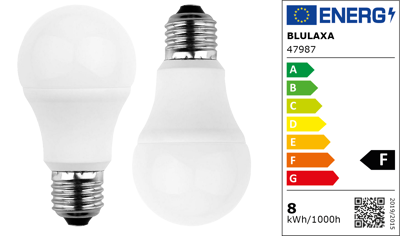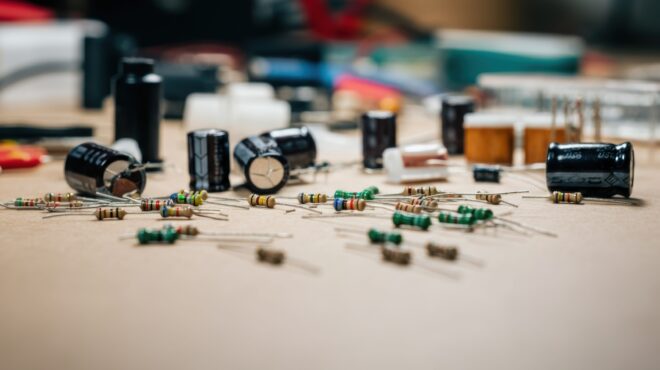
LEDs: Cutting-edge Innovation for a Bright future
Whether for domestic or industrial applications, LED products have become indispensable in lighting technology. We have taken a closer look at this innovative technology and can tell you which criteria are most important when choosing a product. Read on to find out more!
Historical background of LEDs
It all began in the 1960s, when the newly developed light-emitting diodes (LEDs) were first used in low-power applications such as indicator lights and watch displays. These pioneering models were not yet ready to replace incandescent lamps. The first LEDs were only available in red and green and were not bright enough.
The breakthrough came in 1993 with the development of the first bright blue LED. The light it produces appears bright and white to the eye. These models were now a viable alternative to incandescent bulbs in almost all applications, from street lighting to industrial lighting.
Today, improvements in LED manufacturing technology make it possible to produce low-cost, long-lasting components that offer excellent value for money.
But what information and values need to be considered when buying LED products? We will clarify this!
LEDs: What to look out for?
Understanding LED specifications is important in order to find the right solution for a specific application. For example, for professionals designing office lighting, energy efficiency is a key factor. In contrast, when choosing signal lights, the colour intensity of the LEDs is more important.
Make sure you understand your specific requirements in advance and take into account the associated reference values.
LEDs: important reference values
Whether you are buying a torch, a work lamp or a signal lamp for industrial production facilities, you should look for different information on the packaging or in the product description, depending on the light source and the application. Below is an overview of the most important parameters, including descriptions, formulae and practical tips.
Power consumption (watts)
The wattage of a light source indicates how much electricity it consumes when in use. It is also the basis for determining the efficiency of a product.
Lumen (lm)
The luminous flux or total output of a light source is measured in lumens. This means how much light a light source emits per unit of time. A light source with more lumens will therefore emit more light.
The lumen rating helps to quantify the brightness of a light source. However, the actual output of a light source depends largely on the lamp or lamp housing in which it is housed. For example, a car headlight concentrates the light in a forward beam, while living room lights spread the light around the room.
Formula: Lumen = luminous flux / luminous intensity
Luminous efficacy (η)
Luminous efficacy is essential for determining the efficiency of light sources. It is expressed in lumens per watt (lm/W) and indicates how much energy must be used to produce a given luminous flux.
As a rule, the higher the number, the more efficient the light.
LED light sources have a high luminous efficacy of 180 lm/W.
By comparison:
- Incandescent lamp: 12 lm/W
- Halogen lamp: 25 lm/W
- Energy saving lamp: 86 lm/W
Lux (lx)
Lux measures the amount of light falling on a surface. It is measured in lumens per square metre. Values of around 300 to 1,000 lux are common for offices, classrooms or studies. Laboratories have particularly high lux values, while warehouses tend to be at the lower end of the scale with 50 lux.
By way of comparison, sunlight can reach values in excess of 100,000 lux.
In general, the larger the area to be illuminated, the higher the number of lumens required to achieve the desired lux level.
The formula: Lux = luminous flux/area in m2
Candela (cd)
The candela is the unit used to measure luminous intensity. Sometimes called luminance, it describes the surface brightness perceived by the human eye.
Manufacturers rarely quote candela values as they always refer to a specific beam direction. However, this physical quantity is of interest for lamps and light sources that emit the same luminous flux in all directions. Similarly, the beam angle can be an important value to look at. This is because beam angle and lumen can be related to compare luminaires in terms of their luminous intensity in candelas.
In general terms, the wider the beam angle, the fewer candelas will be produced by a solid angle with the same lumen output.
Formula: luminous intensity in cd = luminous flux/solid angle
Kelvin (K)
Depending on the application, the colour of the light is also important. This is indicated by the colour temperature in Kelvin. Values around 3,000 Kelvin are called warm white and are suitable for cosy interiors. Light colours above 5,300 Kelvin have a higher blue light component. Such daylight white luminaires have a stimulating effect on the human body and are therefore particularly suitable for offices or computer screens.
LED products from Bürklin
Are you looking for high quality and efficient LED light sources? You are guaranteed to find them in the Bürklin online shop! From LED modules, LED spacers and LED connectors to LED torches, LED signal lamps and columns for industrial use: Order your desired product in just a few steps and contact our expert staff if you have any questions.












